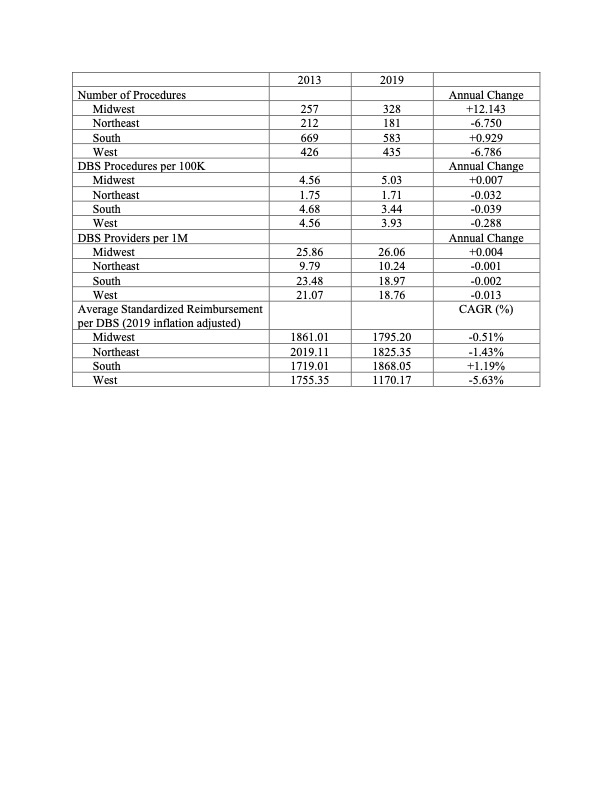Category: Epidemiology
Objective: To evaluate the utilization of deep brain stimulation within the Medicare population across different regions and states in the United States
Background: Deep brain stimulation (DBS) is being evaluated as a treatment in over 50 different disorders involving 31 distinct brain targets,1 with the most common indication being the treatment of Parkinson’s disease.2 A study from a tertiary referral center found that 1.4% of PD patients from 2009-2014 underwent DBS.3 In 2006, it is estimated that 4200 DBS procedures were performed in the United States.4 Since then, there has been limited data on the number of DBS in the United States.
Method: The CMS Physician and Other Supplier Public Use File (POSPUF), a 100% Part B fee-for-service claims database, was utilized to determine the number of DBS procedures performed under the codes 61863 and 61867, from 2013 to 2019. The number of providers performing the procedure was extracted as well, and both provider and procedure numbers were normalized by the number of beneficiaries. Additionally, the average Medicare reimbursement amount for DBS procedures were determined annually and compound annual growth rates were calculated after adjusting for inflation. Data analysis was stratified by the 4 U.S. regions as determined by the U.S. Census Bureau.
Results: Nationally, there were 1564 procedures performed by 79 providers in 2013 and 1527 performed by 75 providers in 2019. Regionally, the annual change between 2013 and 2019 in procedures for the Midwest was +12.14, the Northeast -6.75, the South +0.929, and West -6.79. The number of DBS procedures per 100K beneficiaries as well as the number of providers performing DBS per 1 million beneficiaries was consistent across all years 2013 to 2019 with no significant difference in regions between 2013 and 2019. After adjusting all dollars for 2019 values, the average standardized payment amount by Medicare decreased from $1795.62 in 2013 to $1670.59 in 2019, resulting in a CAGR of -1.03%. There was no significant difference in regions in 2013 but significant difference in 2019, with West having the lowest amount. Specific values for variable outcomes can be visualized in [table 1].
Conclusion: Deep brain stimulation utilization and cost has remained stable over the past 8 years. Future studies should continue to be done to evaluate trends, clinical indications, and barriers to standards of care.
References: 1. Harmsen IE, Wolff Fernandes F, Krauss JK, Lozano AM. Where Are We with Deep Brain Stimulation? A Review of Scientific Publications and Ongoing Research. Stereotact Funct Neurosurg. 2022:1-14.
2. Krack P, Volkmann J, Tinkhauser G, Deuschl G. Deep Brain Stimulation in Movement Disorders: From Experimental Surgery to Evidence-Based Therapy. Mov Disord. 2019;34(12):1795-1810.
3. Kestenbaum M, Ford B, Louis ED. Estimating the Proportion of Essential Tremor and Parkinson’s Disease Patients Undergoing Deep Brain Stimulation Surgery: Five-Year Data From Columbia University Medical Center (2009-2014). Mov Disord Clin Pract. 2015;2(4):384-387.
4. Lad SP, Kalanithi PS, Patil CG, et al. Socioeconomic Trends in Deep Brain Stimulation (DBS) Surgery. Neuromodulation. 2010;13(3):182-186.
To cite this abstract in AMA style:
T. Gossard, A. Khurana, J. Chan, S. Aslam. Geographic and Financial Trends in the Utilization of Deep Brain Stimulation in the Medicare Population from 2013-2019 [abstract]. Mov Disord. 2022; 37 (suppl 2). https://www.mdsabstracts.org/abstract/geographic-and-financial-trends-in-the-utilization-of-deep-brain-stimulation-in-the-medicare-population-from-2013-2019/. Accessed April 2, 2025.« Back to 2022 International Congress
MDS Abstracts - https://www.mdsabstracts.org/abstract/geographic-and-financial-trends-in-the-utilization-of-deep-brain-stimulation-in-the-medicare-population-from-2013-2019/

